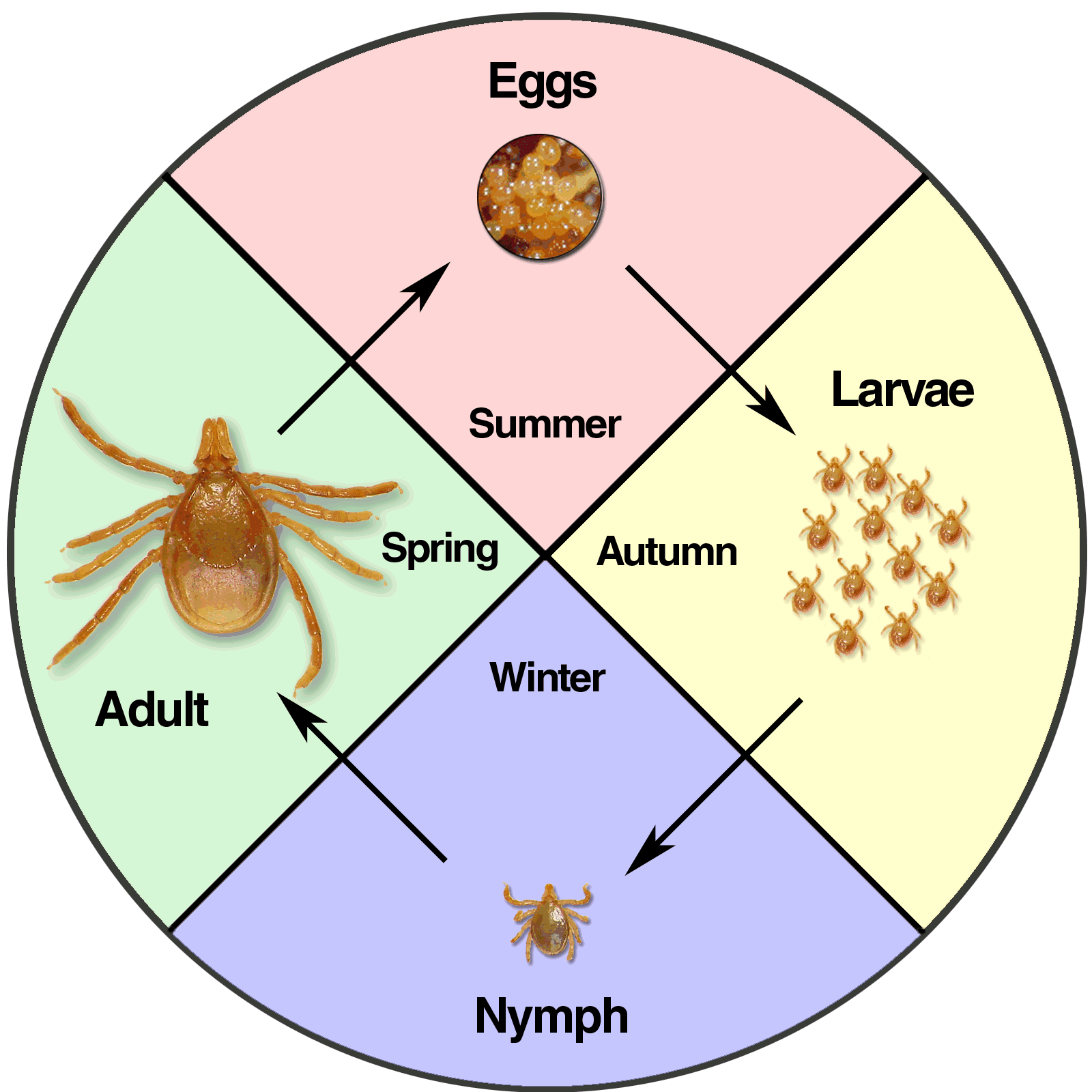tick life cycle uk
This period is dependent on the availability of. After hatching from the eggs ticks must eat blood at each stage in order to move on to the next one.

The Tick Life Cycle Printed With Permission From Jeremy Gray Eucalb Download Scientific Diagram
A tick begins its life as an egg.

. The sheep tick is distributed widely all over the UK but prefers dense vegetation and warm wet conditions to support the free living stages of its life cycle. Most ticks go through four life stages. Ticks go through four life stages.
On dogs ticks often attach themselves in crevices andor areas with little to no hair typically in and around the ears the areas where the insides of the legs meet the body. Basically the tick needs three distinct blood meals for it to complete its development. Its important to be familiar with this.
During its life the tick will feed on three different hosts. The Life Cycle Of A Tick Diagram. After hatching the larva seeks a host feeds and then drops off to moult to the nymphal.
Once a tick egg hatches it has to feed on blood at every stage of its life cycle for the rest of its life in order to survive. Ticks are the food of mammals birds reptiles and amphibians among other things. Ixodes scapularis the black-legged deer tick which is the primary vector for Lyme disease has a four-stage life cycle and a lifespan of about two years.
When ticks search for a. Ticks are tiny parasitic spider-like creatures commonly found in woodland heathland and moorland. Egg six-legged larva eight-legged nymph and adult.
It can take up to 3 years to complete a. It takes 3 to 36 months for ticks to complete their lifecycle. A tick starts life as an egg and because tick mortality is so high.
When the egg hatches a six-legged larva emerges. After hatching from the eggs ticks must eat blood at every stage to survive. Tick biology and ecology Ticks in the UK Tick-borne Disease in the UK National Tick Survey Lifecycle of a tick Tick life cycle Tick life cycle Environmental Conditions Suitable.
Ticks that require this many hosts can take up to 3 years to complete their full life cycle and most will die. The life cycle takes on average three years to complete. The most popular tick is the hard tick called American dog tick that feeds on the dog for several days.
Generally there are two peaks of tick activity in the spring and in the late summerautumn. Deer tick eggs hatch into larvae in the. The main importance of ticks is their role as vectors of pathogenic agents which cause a range of tick-borne diseases TBDs.
This species is the principal vector of Lyme Disease. In the UK the most important tick species to human health is Ixodes ricinus more commonly known as the sheep castor bean or deer tick. Its first host is usually.
The life cycle of a tick can be divided into four sections. Since there are so many different tick species the duration of this life cycle varies greatly from a. We have all seen dogs scratching themselves rigorously when they suffer from tick.
Aside from its missing set of legs the larva looks a lot like an adult tick. Some pathogens can be transmitted between different tick. Aside from its missing set of legs the larva looks a lot like an adult tick.
However ticks are also often found on lower lying areas of rougher grazing field boundaries etc. Ticks in the larval nymph and adult stages can live for. Egg larva nymph and adult.
The life cycle of a deer tick consists of four stages beginning with an egg laid by a mature female. If the host animal that the tick feeds on has a bloodborne infection the tick will ingest the pathogens and become infected itself. The Deer Initiative Ticks Lyme Disease What are Ticks.
As ticks require multiple hosts in order to progress. Larvae nymph adult and egg. A tick begins its life as an egg.
There is increasing awareness of. At each stage of. The brown dog tick for example prefers to feed on the same host throughout its life cycle.
The life cycle of ixodids can take from 1 to 6 years and involves 4 stages. Many ticks go through a three host life cycle meaning that they parasite three different host bodies during their lifetime. About 8 weeks after being laid.
The life cycle of a deer tick lasts about two years and begins in the early spring when an adult female engorged full with blood lays fertilized eggs. Its important to be familiar with.

Tick Season Is Upon Us Larkmead Veterinary Group

Pathogens Free Full Text Experimental Infection Of Ticks An Essential Tool For The Analysis Of Babesia Species Biology And Transmission Html

Ticks On Dogs And Cats The Veterinary Nurse
9 Types Of Ticks And How To Identify Them Mega Guide Bug Lord

Ticks And Disease In Kentucky Entomology

Lyme Disease In Horses 2022 Forageplus Talk

Life Cycle Tick Bug Common Hosts Stock Vector Royalty Free 266745956 Shutterstock

The Tick Lifecycle Lyme Tick Borne Disease Testing Statistics
Life Cycle Visa Vis Symposiums

An Overview Of Tick Paralysis Symptoms Treatment And Prevention

Blacklegged Ticks Keep On Ticking Regardless Of Winter Kentucky Pest News
Ticks Effects Control And Life Cycle
Ticks Effects Control And Life Cycle

Trek Tragedy Review On Lyme Disease Rcemlearning

Tick Vector An Overview Sciencedirect Topics

Life Cycle Of Ixodes Ricinus And Transmission Of Rodent Associated Download Scientific Diagram

